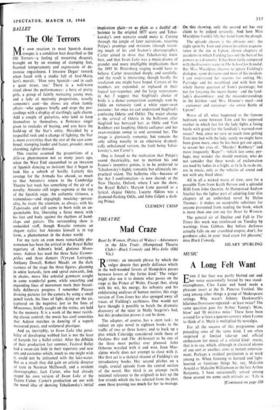MUSIC
A Long Felt Want
EVEN if her face was partly blotted out and her voice occasionally forced by two stand- microphones, Cleo LaMe and band made a pleasant insert at the St. Pancras Festival. She sang among other things a group of Shakespeare settings. Why wasn't Johnny Dankworth's hilarious Dunsinane repeated—at least twice? The same question goes for Arthur Young's 'Blow, blow' and '0 mistress mine.' These have been around for at least a quarter-century when I come to think of it. Merit is multiplied by nostalgia.
For all the success of this programme and preceding ones of the same kind, I am often surprised at limited take-up and official enthusiasm for music of a related kind: music, that is to say, which, although in classical idioms of one sort or another, aims at instant entertain- ment. Perhaps a residual puritanism is at work among us. When listening to learned and light- hearted or facetious things by, say, Malcolm Arnold or Malcolm Williamson or the late Arthur Benjamin, I have occasionally sensed among those around me some such attitude as: 'Life is
[Continued on page 330
a vale of tears. So is music. The composer's first duty is to conquer Posterity, even if that means foxing contemporary ears. His second duty is to wring hearts and withers. A composer who's understood immediately is suspect, to say the least. A composer who titillates and amuses into the bargain is so flagrantly immoral that he might as well hawk reefers in disorderly houses and have done with it.'
These reflections are prompted by Joseph Horovitz's Jazz Harpsichord Concerto which he conducted in the Euston Road town hall with the Philomusica Orchestra and a distinguished soloist, George Malcolm. Mr. Horovitz's piece is in three movements and less than fifteen minutes long. I found most of it a tingling delight. The part-writ- ing and structure of the outer movements are J. S. Bach, with cheeky syncopations and neo- Ellington harmonies that work in as naturally as could be. The middle movement, a slow blues, is the usual purple smoulder, with a crackling, elegant cadenza. For want of a more independent second subject, the opening movement, in early sonata form, tails off rather. But the concerto as a whole, while not intended for a minute beyond its day and (perhaps) half-generation, is such a joy here and now that the mystery remains. Why isn't there a greater official demand for such ephemera? The audience fell for it in a way that suggests a LONG FELT WANT. What heightened their sub-euphoria was the dim, trudg- ing piece that had gone before.
There is a Charles Ives lobby which looks upon this American symphonist (1874-1954) as sage and seer. As Mr. Horovitz conducted the first London performance of Ives's Symphony No. 3, I found myself saying to myself: 'This is bad music.' Next day I listened with miniature score to the Mercury recording and said: 'It's even worse.'
But here a miracle. On the reverse is an Ives orchestral piece I didn't know: Three Places in New England. In this there's hardly a page that isn't distinctive, decades ahead of its time (pre- 1914) and logical with a logic of its own. Half the score, though innocent of contemporary romantic formulae, is drenched with romanticism. The rest is packed with popular material (e.g., military bands marching opposite ways in different keys) handled with an irmination that strikes like lightning. Sd Symphony No. 3 is forgiven. Now to forget it.
CHARLES REID



































 Previous page
Previous page